Physical activity interventions for people with congenital heart disease
- PMID: 33112424
- PMCID: PMC8490972
- DOI: 10.1002/14651858.CD013400.pub2
Physical activity interventions for people with congenital heart disease
Abstract
Background: Congenital heart disease (ConHD) affects approximately 1% of all live births. People with ConHD are living longer due to improved medical intervention and are at risk of developing non-communicable diseases. Cardiorespiratory fitness (CRF) is reduced in people with ConHD, who deteriorate faster compared to healthy people. CRF is known to be prognostic of future mortality and morbidity: it is therefore important to assess the evidence base on physical activity interventions in this population to inform decision making.
Objectives: To assess the effectiveness and safety of all types of physical activity interventions versus standard care in individuals with congenital heart disease.
Search methods: We undertook a systematic search on 23 September 2019 of the following databases: CENTRAL, MEDLINE, Embase, CINAHL, AMED, BIOSIS Citation Index, Web of Science Core Collection, LILACS and DARE. We also searched ClinicalTrials.gov and we reviewed the reference lists of relevant systematic reviews.
Selection criteria: We included randomised controlled trials (RCT) that compared any type of physical activity intervention against a 'no physical activity' (usual care) control. We included all individuals with a diagnosis of congenital heart disease, regardless of age or previous medical interventions. DATA COLLECTION AND ANALYSIS: Two review authors (CAW and CW) independently screened all the identified references for inclusion. We retrieved and read all full papers; and we contacted study authors if we needed any further information. The same two independent reviewers who extracted the data then processed the included papers, assessed their risk of bias using RoB 2 and assessed the certainty of the evidence using the GRADE approach. The primary outcomes were: maximal cardiorespiratory fitness (CRF) assessed by peak oxygen consumption; health-related quality of life (HRQoL) determined by a validated questionnaire; and device-worn 'objective' measures of physical activity.
Main results: We included 15 RCTs with 924 participants in the review. The median intervention length/follow-up length was 12 weeks (12 to 26 interquartile range (IQR)). There were five RCTs of children and adolescents (n = 500) and 10 adult RCTs (n = 424). We identified three types of intervention: physical activity promotion; exercise training; and inspiratory muscle training. We assessed the risk of bias of results for CRF as either being of some concern (n = 12) or at a high risk of bias (n = 2), due to a failure to blind intervention staff. One study did not report this outcome. Using the GRADE method, we assessed the certainty of evidence as moderate to very low across measured outcomes. When we pooled all types of interventions (physical activity promotion, exercise training and inspiratory muscle training), compared to a 'no exercise' control CRF may slightly increase, with a mean difference (MD) of 1.89 mL/kg-1/min-1 (95% CI -0.22 to 3.99; n = 732; moderate-certainty evidence). The evidence is very uncertain about the effect of physical activity and exercise interventions on HRQoL. There was a standardised mean difference (SMD) of 0.76 (95% CI -0.13 to 1.65; n = 163; very low certainty evidence) in HRQoL. However, we could pool only three studies in a meta-analysis, due to different ways of reporting. Only one study out of eight showed a positive effect on HRQoL. There may be a small improvement in mean daily physical activity (PA) (SMD 0.38, 95% CI -0.15 to 0.92; n = 328; low-certainty evidence), which equates to approximately an additional 10 minutes of physical activity daily (95% CI -2.50 to 22.20). Physical activity and exercise interventions likely result in an increase in submaximal cardiorespiratory fitness (MD 2.05, 95% CI 0.05 to 4.05; n = 179; moderate-certainty evidence). Physical activity and exercise interventions likely increase muscular strength (MD 17.13, 95% CI 3.45 to 30.81; n = 18; moderate-certainty evidence). Eleven studies (n = 501) reported on the outcome of adverse events (73% of total studies). Of the 11 studies, six studies reported zero adverse events. Five studies reported a total of 11 adverse events; 36% of adverse events were cardiac related (n = 4); there were, however, no serious adverse events related to the interventions or reported fatalities (moderate-certainty evidence). No studies reported hospital admissions.
Authors' conclusions: This review summarises the latest evidence on CRF, HRQoL and PA. Although there were only small improvements in CRF and PA, and small to no improvements in HRQoL, there were no reported serious adverse events related to the interventions. Although these data are promising, there is currently insufficient evidence to definitively determine the impact of physical activity interventions in ConHD. Further high-quality randomised controlled trials are therefore needed, utilising a longer duration of follow-up.
Trial registration: ClinicalTrials.gov NCT02283255 NCT02658266 NCT04135859 NCT04208893 NCT04264650.
Copyright © 2020 The Cochrane Collaboration. Published by John Wiley & Sons, Ltd.
Conflict of interest statement
CAW has received funding from Heart Research UK and Canon Medical Systems Ltd to complete research into the heart health of young people. The author had full control of the design of the study, methods used, outcome parameters, analysis of the data and production of any manuscripts. Neither of these organisations have a financial interest in this review. CW has a funded PhD scholarship from the University of Exeter and Canon Medical. Canon Medical Systems Ltd does not have a financial interest in this review. GEP is lead researcher in a contractual research partnership between the University of Bristol and Canon Medical Systems UK Ltd. Canon Medical Systems Ltd does not have a financial interest in this review. GS is Medical Director of Sports Cardiology UK. Research grant from Heart research UK to evaluate an exercise prescription programme in congenital heart patients. Fee for lecturing at scientific meetings and financial support for educational arrhythmia meeting in February 2019 from Medtronic Actelion. None of the organisations named have a financial interest in this review. LL has no known conflicts of interest. RST has no known conflicts of interest.
Figures
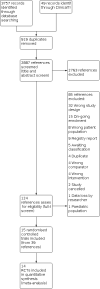

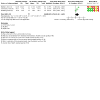
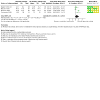
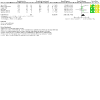


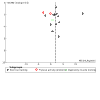
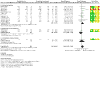
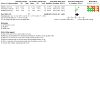
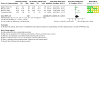
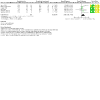

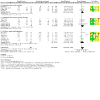
Update of
References
References to studies included in this review
Avila 2016 {published data only}
-
- Avila P, Marcotte F, Dore A, Mercier LA, Shohoudi A, Mongeon FP, et al. Exercise and ventricular arrhythmias in adults with tetralogy of fallot: a randomized pilot clinical trial. Heart Rhythm 2015:S395. - PubMed
-
- Avila P, Marcotte F, Dore A, Mercier LA, Shohoudi A, Mongeon FP, et al. The impact of exercise on ventricular arrhythmias in adults with tetralogy of Fallot. International Journal of Cardiology 2016;219:218-24. [DOI: ] - PubMed
Duppen 2015 {published data only}
-
- Dulfer K, Duppen N, Blom NA, Dijk AP, Helbing WA, Verhulst FC, et al. Effect of exercise training on sports enjoyment and leisure-time spending in adolescents with complex congenital heart disease: the moderating effect of health behavior and disease knowledge. Congenital Heart Disease 2014;9(5):415-23. [DOI: ] - PubMed
-
- Dulfer K, Duppen N, Blom NA, Van Domburg RT, Helbing WA, Verhulst FC, et al. Effects of exercise training on behavioral and emotional problems in adolescents with tetralogy of Fallot or a Fontan circulation: a randomized controlled trial. International Journal of Cardiology 2014;172(3):e425-47. [DOI: ] - PubMed
-
- Dulfer K, Duppen N, Kuipers IM, Schokking M, Domburg RT, Verhulst FC, et al. Aerobic exercise influences quality of life of children and youngsters with congenital heart disease: a randomized controlled trial. Journal of Adolescent Health 2014;55(1):65-72. [DOI: ] - PubMed
-
- Dulfer K, Duppen N, Van Dijk AP, Kuipers IM, Van Domburg RT, Verhulst FC, et al. Parental mental health moderates the efficacy of exercise training on health-related quality of life in adolescents with congenital heart disease. Pediatric Cardiology 2015;36(1):33-40. [DOI: ] - PubMed
-
- Duppen N, Etnel JR, Spaans L, Takken T, van den Berg-Emons RJ, Boersma E, et al. Does exercise training improve cardiopulmonary fitness and daily physical activity in children and young adults with corrected tetralogy of Fallot or Fontan circulation? A randomized controlled trial. American Heart Journal 2015;170(3):606-14. [DOI: ] - PubMed
Fritz 2020 {published data only}
-
- Fritz C, Müller J, Nagdyman N, Oberhoffer R, Ewert P, Hager A. Inspiratory muscle training improves oxygen saturation and hemoglobin levels in patients with fontan circulation - results from a randomized home-based training study. Cardiology in the Young 2019:S29.
-
- Fritz C, Müller J, Oberhoffer R, Ewert P, Hager A. Inspiratory muscle training did not improve exercise capacity and lung function in adult patients with Fontan circulation: a randomized controlled trial. International Journal of Cardiology 2020;305:50-5. [DOI: ] - PubMed
-
- Fritz C, Müller J, Oberhoffer R, Ewert P, Hager A. Inspiratory muscle training did not improve physical capacity in adult patients with Fontan circulation. Cardiology in the Young 2018:S30-1.
Klausen 2016 {published data only}
-
- Klausen SH, Andersen LL, Søndergaard L, Jakobsen JC, Zoffmann V, Dideriksen K, et al. Effects of eHealth physical activity encouragement in adolescents with complex congenital heart disease: the PReVaiL randomized clinical trial. International Journal of Cardiology 2016;221:1100-6. [DOI: ] - PubMed
-
- Klausen SH, Hwiid S, Mikkelsen UR, Hirth A, Wetterslev J, Kjaergaard H, et al. Effects on exercise capacity of eHealth encouragements in adolescents with congenital heart disease; development of a prospective and randomised complex intervention. European Journal of Cardiovascular Nursing 2012:S47-8.
Madhavi 2011 {published data only}
-
- Madhavi K, Abhachandra AG, Maiya G. Influence of graded aerobic exercise in post-surgical adult acyanotic congenital heart disease - a prospective randomized clinical trial. Indian Journal of Physiotherapy & Occupational Therapy 2011;5(4):87-94.
Moalla 2006 {published data only}
-
- Moalla W, Maingourd Y, Gauthier R, Cahalin LP, Tabka Z Ahmaidi S. Effect of exercise training on respiratory muscle oxygenation in children with congenital heart disease. European Journal of Cardiovascular Prevention and Rehabilitation 2006;13(4):604-11. - PubMed
-
- Moalla W, Elloumi M, Chamari K, Dupont G, Maingourd Y, Tabka Z, et al. Training effects on peripheral muscle oxygenation and performance in children with congenital heart diseases. Applied Physiology, Nutrition and Metabolism 2012;37(4):621-30. - PubMed
-
- Moalla W, Gauthier R, Maingourd Y, Ahmaidi S. Six-minute walking test to assess exercise tolerance and cardiorespiratory responses during training program in children with congenital heart disease. International Journal of Sports Medicine 2005;26(9):756-62. - PubMed
Morrison 2013 {published data only}
-
- Morrison ML, Sands AJ, McCusker CG, McKeown P, McMahon M, Gordon J, et al. Exercise training improves activity and psychosocial wellbeing in adolescents with congenital heart disease. Irish Journal of Medical Science 2011:S398-9.
-
- Morrison ML, Sands AJ, McCusker CG, McKeown PP, McMahon M, Gordon J, et al. Exercise training improves activity in adolescents with congenital heart disease. BMJ Heart 2013;99(15):1122-8. [DOI: ] - PubMed
Novakovic 2018 {published data only}
-
- Novaković M, Prokšelj K, Rajkovič U, Cuderman TV, Trontelj KJ, Fras Z, et al. Exercise training in adults with repaired tetralogy of Fallot: a randomized controlled pilot study of continuous versus interval training. International Journal of Cardiology 2018;255:37-44. [DOI: ] - PubMed
Opotowsky 2018 {published data only}
-
- Opotowsky AR, Rhodes J, Landzberg MJ, Bhatt AB, Shafer KM, Yeh DD, et al. A randomized trial comparing cardiac rehabilitation to standard of care for adults with congenital heart disease. World Journal for Pediatric and Congenital Heart Surgery 2018;9(2):185-93. [DOI: ] - PubMed
-
- Opotowsky AR, Rhodes J, Moko L, Bradley R, Systrom D, Waxman A, et al. A randomized trial of cardiac rehabilitation for adolescents and adults with congenital heart disease. Journal of the American College of Cardiology 2016;13(Suppl 1):987. - PubMed
-
- Tikkanen AU, Rhodes J, Landzberg M, Bhatt A, Systrom DM, Waxman A, et al. A randomized trial of cardiac rehabilitation for adolescents and adults with congenital heart disease. PM&R 2016:S169. - PubMed
Sandberg 2018 {published data only}
-
- Sandberg C, Hedstrom M, Wadell K, Dellborg M, Ahnfelt A, Zetterstrom AK, et al. Home-based interval training increases endurance capacity in adults with complex congenital heart disease. Congenital Heart Disease 2018;13(2):245-62. [DOI: ] - PubMed
-
- Sandberg C, Hedstrom M, Dellborg M, Magnusson A, Zetterstom AK, Wadell K, et al. Increased endurance capacity in adults with complex congenital heart disease after home-based interval exercise training on ergometer cycle. European Heart Journal 2015:458.
Therrien 2003 {published data only}
-
- Therrien J, Fredriksen P, Walker M, Granton J, Reid G, Webb G. A pilot study of exercise training in adult patients with repaired tetralogy of Fallot. Canadian Journal of Cardiology 2003;19(6):685-9. - PubMed
van der Mheen 2019 {published data only}
-
- Van Der Mheen M, McCusker CG, Van Beynum IM, Dulfer K, Van Galen E, Bogers AJ, et al. CHIP-Family to improve psychosocial wellbeing of young children with congenital heart disease and their families. Cardiology in the Young 2018:S28. - PubMed
-
- Mheen M, Meentken MG, Beynum IM, Van Der Ende J, Van Galen E, Zirar A, et al. CHIP-Family intervention to improve the psychosocial well-being of young children with congenital heart disease and their families: results of a randomised controlled trial. Cardiology in the Young 2019;29(9):1172-82. [DOI: ] - PubMed
van Dissel 2019 {published data only}
-
- Hooglugt JQ, Van Dissel AC, De Haan FH, Blok IM, Jorstad HR, Mulder BJ, et al. Efficacy and compliance of long-term, individualised exercise training in adults with congenital heart disease and heart failure symptoms: a randomized controlled trial. European Heart Journal 2018:Suppl 1:245.
-
- Dissel AC, Blok IM, Hooglugt JL, Haan FH, Jørstad HT, Mulder BJ, et al. Safety and effectiveness of home-based, self-selected exercise training in symptomatic adults with congenital heart disease: A prospective, randomised, controlled trial. International Journal of Cardiology 2019;278:59-64. [DOI: ] - PubMed
Westhoff‐Bleck 2013 {published data only}
-
- Westhoff-Bleck M, Schieffer B, Tegtbur U, Meyer GP, Hoy L, Schaefer A, et al. Aerobic training in adults after atrial switch procedure for transposition of the great arteries improves exercise capacity without impairing systemic right ventricular function. International Journal of Cardiology 2013;170(1):24-9. [DOI: ] - PubMed
Winter 2012 {published data only}
-
- Balducci A, Winter MM, Fabi M, Donti A, Prandstraller D, Formigari R, et al. Exercise training is beneficial and safe in adult patients with a systemic right ventricle. Giornale Italiano di Cardiologia 2011:16S.
-
- Van Der Bom T, Winter MM, De Vries LCS, Bouma BJ, Van Dijk APJ, Van Der Plas MN, et al. Exercise training improves exercise capacity in adult patients with a systemic right ventricle. European Heart Journal 2010:Suppl 1:615. - PubMed
-
- Van Der Bom T, Winter MM, Knaake JL, Cervi E, De Vries LS, Balducci A, et al. Long-term benefits of exercise training in patients with a systemic right ventricle. International Journal of Cardiology 2015;179(105):105-11. [DOI: ] - PubMed
-
- Winter MM, Bom T, Vries LC, Balducci A, Bouma BJ, Pieper PG, et al. Exercise training improves exercise capacity in adult patients with a systemic right ventricle: a randomized clinical trial. European Heart Journal 2012;33(11):1378-85. [DOI: ] - PubMed
References to studies excluded from this review
Ali Faisal 2016 {published data only}
Altamirano Diaz 2017 {published data only}
Amedro 2019 {published data only}
-
- Amedro P, Gavotto A, Legendre A, Lavastre K, Bredy C, De La Villeon G, et al. Impact of a centre and home-based cardiac rehabilitation program on the quality of life of teenagers and young adults with congenital heart disease: the QUALI-REHAB study rationale, design and methods. International Journal of Cardiology 2019;283:112-8. [DOI: ] - PubMed
Babu 2013 {published data only}
Babu 2017 {published data only}
-
- Babu AS, Ramachandran P, Maiya AG. Effects of home-based exercise training in Eisenmenger's syndrome: secondary analysis from a RCT. Journal of Cardiopulmonary Rehabilitation and Prevention 2017;37(5):367-8. [DOI: ]
Becker Gruenig 2012 {published data only}
-
- Becker-Gruenig T, Ehlken N, Gorenflo M, Hager A, Halank M, Klose H, et al. Efficacy of exercise training in congenital heart disease associated pulmonary hypertension. European Respiratory Journal 2012;40(56):P927.
Bhasipol 2018 {published data only}
-
- Bhasipol A, Sanjaroensuttikul N, Pornsuriyasak P, Yamwong S, Tangcharoen T. Effect of the home cardiac rehabilitation program for adult with complex congenital heart disease: the EMPOWER trial. European Heart Journal 2018;39(Suppl 1):22. [DOI: ] - PubMed
Bhasipol 2018a {published data only}
-
- Bhasipol A, Sanjaroensuttikul N, Pornsuriyasak P, Yamwong S, Tangcharoen T. Efficiency of the home cardiac rehabilitation program for adults with complex congenital heart disease. Congenital Heart Disease 2018;13(6):952-8. [DOI: ] - PubMed
BoaSorteSilva 2017 {published data only}
-
- Boa Sorte Silva NC, Gregory MA, Gill DP, Petrella RJ. Multiple-modality exercise and mind-motor training to improve cardiovascular health and fitness in older adults at risk for cognitive impairment: a randomized controlled trial. Archives of Gerontology and Geriatrics 2017;68:149‐60. [DOI: 10.1016/j.archger.2016.10.009] - DOI - PubMed
Callaghan 2018 {published data only}
-
- Callaghan S, Morrison ML, McCusker C, McKeown P, Casey F. A structured intervention programme can improve the biophysical wellbeing in children with congenital heart disease. Ulster Medical Journal 2018;87(2):146.
Camargo 2007 {published data only}
-
- Camargo DM, Campos MT, Sarmiento JM, Garzón M, Navia J, Merchán A. Hemodynamic response to training in resistance and muscular strength of upper limbs in cardiac rehabilitation [Respuesta hemodinámica con el entrenamiento en resistencia y fuerza muscular de miembros superiores en rehabilitación cardiaca]. Revista Colombiana de Cardiología 2007;14(4):198-206.
Chen 2017 {published data only}
-
- Chen CW, Fanjiang YY, Chiang YT, Ho CL. Mobile health program to promote self management in youths with congenital heart disease design and development of the cool randomized controlled trial. Cardiology in the Young 2017;27(4):S89. [DOI: ]
Coats 1992 {published data only}
Cordina 2013 {published data only}
-
- Cordina RL, O'Meagher S, Karmali A, Rae CL, Liess C, Kemp GJ, et al. Resistance training improves cardiac output, exercise capacity and tolerance to positive airway pressure in Fontan physiology. International Journal of Cardiology 2013;168(2):780-8. [DOI: ] - PubMed
Curnier 2012 {published data only}
-
- Curnier D, Lalonde F, Mathieu ME, Fournier A, Bigras JL, Miro J, et al. Children with congenital heart disease and exercise rehabilitation. Journal of Cardiopulmonary Rehabilitation and Prevention 2012;32(4):232. [DOI: ]
DRKS00011363 {published data only}
-
- DRKS00011363. Breathing training in children, adolescents and young adults with Tetralogy of Fallot after total surgical repair. www.who.int/trialsearch/Trial2.aspx?TrialID=DRKS00011363 (accesed prior to 21 October 2020).
Du 2015 {published data only}
Du 2017 {published data only}
Dua 2010 {published data only}
-
- Dua JS, Cooper AR, Fox KR, Graham Stuart A. Exercise training in adults with congenital heart disease: feasibility and benefits. International Journal of Cardiology 2010;138(2):196-205. [DOI: ] - PubMed
Fredriksen 2000 {published data only}
-
- Fredriksen PM, Walker M, Granton J, Webb G, Reid G, Therrien J. A controlled trial of exercise training in adult patients with repaired tetralogy of Fallot. Canadian Journal of Cardiology 2000;16(Suppl F):137F. - PubMed
Fredriksen 2000a {published data only}
-
- Fredriksen PM, Kahrs N, Blaasvaer S, Sigurdsen E, Gundersen O, Roeksund O, et al. Effect of physical training in children and adolescents with congenital heart disease. Cardiology in the Young 2000;10(2):107-14. - PubMed
Gierat Haponiuk 2014 {published data only}
Goldbeck 2011 {published data only}
-
- Goldbeck L, Holling I, Schlack R, West C, Besier T. The impact of an inpatient family-oriented rehabilitation program on parent-reported psychological symptoms of chronically ill children. Klinische Pädiatrie 2011;223(2):79-84. [DOI: ] - PubMed
Gomes Neto 2016 {published data only}
-
- Gomes-Neto M, Saquetto, MB, da Silva e Silva CM, Conceicao CS, Carvalho VO. Impact of exercise training in aerobic capacity and pulmonary function in children and adolescents after congenital heart disease surgery: a systematic review with meta-analysis. Pediatric Cardiology 2016;37(2):217-24. [DOI: ] - PubMed
Gotink 2017 {published data only}
Hedlund 2018 {published data only}
Hooglugt 2018a {published data only}
-
- Hooglugt JQ, van Dissel AC, Blok IM, de Haan FH, Jorstad HT, Bouma BJ, et al. The effect of exercise training in symptomatic patients with grown-up congenital heart disease: a review. Expert Review of Cardiovascular Therapy 2018;16(6):379-86. [DOI: ] - PubMed
IlarrazaLomel 2008 {published data only}
-
- Ilarraza Lomelí H, Quiroga P, Rius Suárez MD. Cardiac rehabilitation in children [Rehabilitación cardíaca en población pediátrica. Más allá que ayudar a un niño a readaptar su corazón]. Archivos de Cardiología de México 2008;78(2):129-33. - PubMed
IoannisLaoutaris 2015 {published data only}
-
- Ioannis Laoutaris ID, Dritsas A, Kariofyllis P, Manginas A. Benefits of inspiratory muscle training in patients with pulmonary arterial hypertension. European Journal of Preventive Cardiology 2015;22(Suppl 1):S78. [DOI: ] - PubMed
IRCT20180417039341N1 {published data only}
-
- IRCT20180417039341N1. Evaluation of self-care education on self-efficacy and quality of life in adolescents with congenital heart disease. www.who.int/trialsearch/Trial2.aspx?TrialID=IRCT20180417039341N1 (accessed prior to 21 October 2020).
ISRCTN74393113 {published data only}
-
- ISRCTN74393113. Biophysical & psychosocial wellbeing in children with congenital heart disease. www.who.int/trialsearch/Trial2.aspx?TrialID=ISRCTN74393113 (accessed prior to 21 October 2020).
Joshi 2019 {published data only}
-
- Joshi VL, Tang LH, Zwisler AD, Taylor RS. Rehabilitation for people with cardiac conditions: an overview of systematic reviews. Physiotherapy (United Kingdom) 2019;105(Suppl 1):e11-2. [DOI: ]
Kobashigawa 1999 {published data only}
-
- Kobashigawa JA, Leaf DA, Lee, N, Gleeson MP, Liu H, Hamilton MA, et al. A controlled trial of exercise rehabilitation after heart transplantation. New England Journal of Medicine 1999;340(4):272-7. - PubMed
Lalonde 2014 {published data only}
-
- Lalonde D, Welisch E, Altamirano-Diaz L, De Jesus S, Prapavessis H, Rombeek M, et al. The impact of a structured lifestyle intervention on body composition and exercise capacity in obese children with congenital heart defect (Smart Heart Trial). Journal of Physical Activity and Health 2014;11:S163-4.
Lam 2014 {published data only}
-
- Lam K, Dias P, Green G, Maiorana A. Echocardiographic Findings of chronic heart failure patients following exercise training. Journal of the American Society of Echocardiography 2014;27(6):B119.
Longmuir 1985 {published data only}
-
- Longmuir PE, Turner JA, Rowe RD, Olley PM. Postoperative exercise rehabilitation benefits children with congenital heart disease. Clinical and Investigative Medicine 1985;8(3):232-8. - PubMed
Longmuir 2013 {published data only}
-
- Longmuir PE, Tyrrell PN, Corey M, Faulkner G, Russell JL, McCrindle BW. Home-based rehabilitation enhances daily physical activity and motor skill in children who have undergone the Fontan procedure. Pediatric Cardiology 2013;34(5):1130-51. [DOI: ] - PubMed
Lozada 2017 {published data only}
-
- Lozada MA, Balderas J, Bunyi MI, Suarez C. Comparison of the effectiveness of four(4) session play module versus the conventional cardiovascular rehabilitation therapy among post operative congenital heart disease pediatric patients ages 5 12 years old. Cardiology in the Young 2017;27(4):S144. [DOI: ]
Marra 2015 {published data only}
McKillop 2018 {published data only}
-
- McKillop A, Grace SL, Ghisi GL, Allison KR, Banks L, Kovacs AH, et al. Adapted motivational interviewing to promote exercise in adolescents with congenital heart disease: a pilot trial. Pediatric Physical Therapy 2018;30(4):326-34. [DOI: ] - PubMed
NCT00930800 {published data only}
-
- NCT00930800. Exercise training in children with congenital heart defect. clinicaltrials.gov/show/nct00930800 (first posted 2 July 2009).
NCT01463800 {published data only}
-
- NCT01463800. Rehabilitation in patients with congenital heart disease. clinicaltrials.gov/show/nct01463800 (first posted 2 November 2011).
NCT01671566 {published data only}
-
- NCT01671566. Interval training in adults with congenital heart disease a randomized trial. clinicaltrials.gov/show/nct01671566 (first posted 23 August 2012).
NCT01822769 {published data only}
-
- NCT01822769. Cardiopulmonary rehabilitation for adolescents and adults with congenital heart disease. clinicaltrials.gov/show/nct01822769 (first posted 2 April 2013).
NCT02632253 {published data only}
-
- NCT02632253. Effects of high-intensity interval training on exercise capacity in patients with grown-up congenital heart disease. clinicaltrials.gov/show/nct02632253 (first posted 16 December 2015).
NCT02643810 {published data only}
-
- NCT02643810. Exercise training in adults with corrected Tetralogy of Fallot. clinicaltrials.gov/show/nct02643810 (first posted 31 December 2015).
NCT02980393 {published data only}
-
- NCT02980393. Smart Heart Trial: structured lifestyle intervention for overweight and obese youth with operated heart defects. clinicaltrials.gov/show/nct02980393 (first posted 2 December 2016).
NCT03297918 {published data only}
-
- NCT03297918. Impact of a structural phonation training on respiratory muscle function in patients with structural heart disease. clinicaltrials.gov/show/nct03297918 (first posted 29 September 2017).
Nehyba 2009 {published data only}
-
- Nehyba S, Chaloupka V, Soucek R, Chaloupkova S, Vysoky R, Stetka F, et al. The programme of managed ambulatory rehabilitation for patients after heart valve defect surgery. Vnitr̆ní Lékar̆ství 2009;55(12):1118-25. - PubMed
NTR2527 {published data only}
-
- NTR2527. High intensity interval training after cardiac resynchronization therapy. www.who.int/trialsearch/Trial2.aspx?TrialID=NTR2527 (date of registration 25 September 2010).
NTR3041 {published data only}
-
- NTR3041. Effects of high intensity interval training on cardiac function at rest and during exercise. www.who.int/trialsearch/Trial2.aspx?TrialID=NTR3041 (date of registration 19 August 2011).
Rhodes 2006 {published data only}
-
- Rhodes J, Curran TJ, Camil L, Rabideau N, Fulton DR, Gauthier NS, et al. Sustained effects of cardiac rehabilitation in children with serious congenital heart disease. Pediatrics 2006;118(3):e586-93. - PubMed
Rowland 2016 {published data only}
Ruttenberg 1983 {published data only}
-
- Ruttenberg HD, Adams TD, Orsmond GS, Conlee RK, Fisher AG. Effects of exercise training on aerobic fitness in children after open heart surgery. Pediatric Cardiology 1983;4(1):19-24. - PubMed
Stefani 2014 {published data only}
Sutherland 2018 {published data only}
-
- Sutherland N, Jones B, Westcamp Aguero S, Melchiori T, du Plessis K, Konstantinov IE, et al. Home- and hospital-based exercise training programme after Fontan surgery. Cardiology in the Young 2018;28(11):1299-305. [DOI: ] - PubMed
Tan 1996 {published data only}
-
- Tan LL, Huang JF, Wang H. The effect of rehabilitation training on postoperative recovery of children with congenital heart disease. Chinese Journal of Nursing 1996;31(6):314-5. - PubMed
Tikkanen 2016 {published data only}
Zhou 2017a {published data only}
-
- Zhou X, Duqing, Sun K. GW28-e0722 randomized controlled trial of a home-based exercise program for children with congenital heart disease following interventional cardiac catheterization: a preliminary study. Journal of the American College of Cardiology (JACC) 2017;70:C165. [DOI: 10.1016/j.jacc.2017.07.601] - DOI - PMC - PubMed
Zhou 2017b {published data only}
References to studies awaiting assessment
Ali 2018 {published data only}
Callaghan 2017 {published data only}
-
- Callaghan S, Morrison ML, McCusker C, McKeown P, Casey F. A structured intervention programme can improve the biophysical wellbeing in children with congenital heart disease. Cardiology in the Young 2017;27(4):S228-9. [DOI: ]
Morrison 2015 {published data only}
-
- Morrison BN, DeSouza AM, Voss C, Potts JE, Sandor GG, Harris KC. The use of individualized exercise prescription and activity trackers to promote physical activity in children with congenital heart disease. Canadian Journal of Cardiology 2015;31(10 Suppl 1):S123-4.
Neidenbach 2017 {published data only}
-
- Neidenbach RC, Oberhoffer R, Nagdyman N, Seitz U, Ewert P, Kaemmerer H, et al. Inspiratory muscle training in children after fontan operation increases oxygen saturation. Cogent Medicine 2017;4(1):18. [DOI: ]
Nilsson 2019 {published data only}
References to ongoing studies
Ganzoni 2019 {published data only}
-
- Ganzoni C, Arslani K, Pfister O, Freese M, Strobel W, Muller C, et al. Regular phonation and respiratory muscle training improve respiratory muscle strength and quality of life in patients with structural heart disease-the HeartChoir randomized clinical controlled trial. Cardiovascular Medicine 2019;22:P29. [DOI: ] - PubMed
ISRCTN74643496 {published data only}
-
- ISRCTN74643496. Improving the effectiveness of psychological interventions for depression and anxiety in the cardiac rehabilitation pathway: a single-blind randomised controlled trial. www.who.int/trialsearch/Trial2.aspx?TrialID=ISRCTN74643496 (date assigned 8 April 2015).
NCT01397110 {published data only}
-
- NCT01397110. Respiratory and physical therapy in patients with associated pulmonary arterial hypertension (APAH) with congenital heart defects. clinicaltrials.gov/show/nct01397110 (first posted 19 July 2011).
NCT02240147 {published data only}
-
- NCT02240147. Start-to-Sport - home-based exercise for adolescents and adults with congenital heart disease. clinicaltrials.gov/show/nct02240147 (first posted 15 September 2014).
NCT02283255 {unpublished data only}
-
- NCT02283255. Cardiovascular, pulmonary and skeletal muscle evaluation in late postoperative period of the Fontan surgery. clinicaltrials.gov/ct2/show/NCT02283255 (first posted 5 November 2014).
NCT02658266 {unpublished data only}
-
- NCT02658266. Effect of resistance training in adults with complex congenital heart disease. clinicaltrials.gov/ct2/show/NCT02658266 (first posted 18 January 2016).
NCT03335475 {published data only}
-
- NCT03335475. Congenital heart disease physical activity lifestyle study. clinicaltrials.gov/show/nct03335475 (first posted 7 November 2017).
NCT03435354 {published data only}
-
- NCT03435354. Enhanced physical activity support in congenital heart disease clinical care. clinicaltrials.gov/show/nct03435354 (first posted 19 February 2018).
NCT03479957 {published data only}
-
- NCT03479957. Remotely monitored and coached cardiac rehabilitation northern Sweden. clinicaltrials.gov/show/nct03479957 (first posted 27 March 2018).
NCT03690518 {published data only}
-
- NCT03690518. Rehabilitation of adolescents and young adults with congenital heart diseases. clinicaltrials.gov/show/nct03690518 (first posted 1 October 2018).
NCT03999320 {published data only}
-
- NCT03999320. Sophrology and congenital heart disease. clinicaltrials.gov/show/nct03999320 (first posted 26 June 2019).
NCT04135859 (YACHD‐PALS) {published data only}
-
- NCT04135859. Young adult congenital heart disease physical activity lifestyle study (YACHD-PALS). clinicaltrials.gov/ct2/show/NCT04135859 (first posted 23 October 2019).
NCT04208893 {published and unpublished data}
-
- NCT04208893. Exercise training strategies for children with repaired Tetralogy of Fallot. clinicaltrials.gov/ct2/show/NCT04208893 (first posted 23 December 2019).
NCT04264650 {published data only}
-
- NCT04264650. Effectiveness of an mHealth intervention for youth with congenital heart disease. clinicaltrials.gov/ct2/show/NCT04264650 (first posted 11 February 2020).
UMIN000021661 {published data only}
-
- UMIN000021661. Evaluation test about safety and efficacy of the respiratory muscle training therapy by abdominal respiratory weight exercises in chronic cardiovascular disease patients. www.who.int/trialsearch/Trial2.aspx?TrialID=JPRN-UMIN000021661 (date of disclosure 1 April 2016).
Additional references
Adams 2017
-
- Adams V, Reich B, Uhlemann M, Niebauer J. Molecular effects of exercise training in patients with cardiovascular disease: focus on skeletal muscle, endothelium, and myocardium. American Journal of Physiology. Heart and Circulatory Physiology 2017;5(313):72-88. - PubMed
Amedro 2015
-
- Amedro P, Dorka R, Moniotte S, Guillaumont S, Fraisse A, Kreitmann B, et al. Quality of life of children with congenital heart diseases: a multicenter controlled cross-sectional study. Pediatric Cardiology 2015;36(8):1588-601. - PubMed
Amedro 2017
-
- Amedro P, Gavotto A, Guillaumont S, Bertet H, Vincenti M, De La Villeon G, et al. Cardiopulmonary fitness in children with congenital heart diseases versus healthy children. Heart (British Cardiac Society) 2017;104(12):1026-36. - PubMed
Best 2016
Brudy 2020
-
- Brudy L, Hock J, Häcker AL, Meyer M, Oberhoffer R, Hager A, et al. Children with congenital heart disease are active but need to keep moving: a cross-sectional study using wrist-worn physical activity trackers. Journal of Pediatrics 2020;217:13-19. - PubMed
Budts 2013
-
- Budts W, Börjesson M, Chessa M, Van Buuren F, Trigo Trindade P, Corrado D, et al. Physical activity in adolescents and adults with congenital heart defects: individualized exercise prescription. European Heart Journal 2013;34(47):3669-74. - PubMed
Budts 2020
-
- Budts W, Pieles GE, Roos-Hesselink JW, Sanz de la Garza M, D’Ascenzi F, Giannakoulas G, et al. Recommendations for participation in competitive sport in adolescent and adult athletes with Congenital Heart Disease (CHD): position statement of the Sports Cardiology & Exercise Section of the European Association of Preventive Cardiology (EAPC), the European Society of Cardiology (ESC) Working Group on Adult Congenital Heart Disease and the Sports Cardiology, Physical Activity and Prevention Working Group of the Association for European Paediatric and Congenital Cardiology (AEPC). European Heart Journal 2020 Aug 26 [E-pub ahead of print]. [DOI: 10.1093/eurheartj/ehaa501] - DOI - PubMed
Campbell 2020
Caspersen 1985
Cedars 2020
Covidence [Computer program]
-
- Covidence systematic review software. Melbourne, Australia: Veritas Health Innovation, accessed before 2 October 2020. Available at www.covidence.org.
Deeks 2017
-
- Deeks JJ, Higgins JP, Altman DG (editors) on behalf of the Cochrane Statistical Methods Group. Chapter 9: Analysing data and undertaking metaanalyses. In: Higgins JP, Churchill R, Chandler J, Cumpston MS (editors), Cochrane Handbook for Systematic Reviews of Interventions version 5.2.0 (updated June 2017), Cochrane, 2017. Available from www.training.cochrane.org/handbook.
Department of Health 2011
-
- Department of Health, Physical Activity, Health Improvement and Protection. Start active, stay active: a report on physical activity from the four home countries. assets.publishing.service.gov.uk/government/uploads/system/uploads/attac... (accessed 13 August 2019).
Dimopoulos 2006
-
- Dimopoulos K, Okonko DO, Diller GP, Broberg CS, Salukhe TV, Babu-Narayan SV, et al. Abnormal ventilatory response to exercise in adults with congenital heart disease relates to cyanosis and predicts survival. Circulation 2006;113(24):2796-802. - PubMed
Dua 2007
-
- Dua J, Cooper AR, Fox KR, Stuart AG. Physical activity levels in adults with congenital heart disease. European Journal of Cardiovascular Prevention and Rehabilitation 2007;14(2):287–93. - PubMed
Egger 1997
Faraone 2008
Franklin 2013
-
- Franklin BA, Lavie CJ, Squires RW, Milani RV. Exercise-based cardiac rehabilitation and improvements in cardiorespiratory fitness: implications regarding patient benefit. Mayo Clinic Proceedings 2013;88(5):431-7. - PubMed
Giardini 2009
-
- Giardini A, Hager A, Lammers AE, Derrick G, Müller J, Diller GP, et al. Ventilatory efficiency and aerobic capacity predict event-free survival in adults with atrial repair for complete transposition of the great arteries. Journal of the American College of Cardiology 2009;53(17):1548-55. - PubMed
Gielen 2010
-
- Gielen S, Schuler G, Adams V. Cardiovascular effects of exercise training molecular mechanisms. Circulation 2010;122(12):1221-38. - PubMed
Glanville 2019
-
- Glanville J, Dooley G, Wisniewski S, Foxlee R, Noel‐Storr A. Development of a search filter to identify reports of controlled clinical trials within CINAHL Plus. Health Information & Libraries Journal 2019;36(1):73-90. - PubMed
Gomes‐Neto 2016
-
- Gomes-Neto M, Saquetto MB, Silva CM, Conceição CS, Carvalho VO. Impact of exercise training in aerobic capacity and pulmonary function in children and adolescents after congenital heart disease surgery: a systematic review with meta-analysis. Pediatric Cardiology 2016;37(2):217-24. - PubMed
GRADEpro GDT [Computer program]
-
- GRADEpro GDT. Hamilton (ON): McMaster University (developed by Evidence Prime, Inc), 2015. Available at gradepro.org.
GraphPad Prism [Computer program]
-
- GraphPad Prism. Version 8.1.0. California USA: GraphPad Software Inc., 2019. Available at www.graphpad.com/scientific-software/prism. [WEBSITE: www.graphpad.com]
Gratz 2009
-
- Gratz A, Hess J, Hager A. Self-estimated physical functioning poorly predicts actual exercise capacity in adolescents and adults with congenital heart disease. European Heart Journal 2009;30(4):497-504. - PubMed
Heran 2008a
Heran 2008b
Higgins 2011
-
- Higgins JP, Green S (editors). Cochrane Handbook for Systematic Reviews of Interventions Version 5.1.0 (updated March 2011). The Cochrane Collaboration, 2011. Available from handbook.cochrane.org.
Higgins 2019
-
- Higgins JP, Savovic J, Page MJ, Elbers RG, Sterne JA. Chapter 8: Assessing risk of bias in a randomized trial. Draft version (29 January 2019) for inclusion in: Higgins JP, Thomas J, Chandler J, Cumpston M, Li T, Page MJ, Welch Va (editors). Cochrane Handbook for Systematic Reviews of Interventions. London: Cochrane. Available from www.training.cochrane.org/handbook.
Hoffman 2002
-
- Hoffman JI, Kaplan S. The incidence of congenital heart disease. Journal of the American College of Cardiology 2002;39(12):1890-900. - PubMed
Kempny 2012
-
- Kempny A, Dimopoulos K, Uebing A, Moceri P, Swan L, Gatzoulis MA, et al. Reference values for exercise limitations among adults with congenital heart disease. Relation to activities of daily life—single centre experience and review of published data. European Heart Journal 2012;33(11):1386–96. - PubMed
Khairy 2010
-
- Khairy P, Ionescu-Ittu R, Mackie AS, Abrahamowicz M, Pilote L, Marelli AJ. Changing mortality in congenital heart disease. Journal of the American College of Cardiology 2010;56(14):1149-57. - PubMed
Koyak 2012
-
- Koyak Z, Harris L, Groot JR, Silversides CK, Oechslin EN, Bouma BJ, et al. Sudden cardiac death in adult congenital heart disease. Circulation 2012;126(16):1944-54. - PubMed
Lee 2012
Lefebvre 2011
-
- Lefebvre C, Manheimer E, Glanville J. Chapter 6: Searching for studies. In: Higgins JPT, Green S (editors). Cochrane Handbook for Systematic Reviews of Interventions Version 5.1.0 (updated March 2011). The Cochrane Collaboration, 2011. Available from handbook.cochrane.org.
Letnes 2019
-
- Letnes JM, Dalen H, Vesterbekkmo EK, Wisløff U, Nes BM. Peak oxygen uptake and incident coronary heart disease in a healthy population: the HUNT Fitness Study. European Heart Journal 2019;40(20):1633–9. [DOI: ] - PubMed
Li 2019
-
- Li X, Chen N, Zhou X, Yang Y, Chen S, Song Y, et al. Exercise training in adults with congenital heart disease: a systematic review and meta-analysis. Journal of Cardiopulmonary Rehabilitation and Prevention 2019;39(5):299-307. - PubMed
Liberati 2009
-
- Liberati A, Altman DG, Tetzlaff J, Mulrow C, Gøtzsche PC, Ioannidis JP, et al. The PRISMA statement for reporting systematic reviews and meta-analyses of studies that evaluate health care interventions: explanation and elaboration. PLoS medicine 2009;6(7):e1000100. [10.1371/journal.pmed.1000100] - PMC - PubMed
Liu 2019
McCrindle 2007
-
- McCrindle BW, Williams RV, Mital S, Clark BJ, Russell JL, Klein G, et al. Physical activity levels in children and adolescents are reduced after the Fontan procedure, independent of exercise capacity, and are associated with lower perceived general health. Archives of Disease in Childhood 2007;92(6):509-14. - PMC - PubMed
Meyer 2020
-
- Meyer M, Brudy L, García-Cuenllas L, Hager A, Ewert P, Oberhoffer R, et al. Current state of home-based exercise interventions in patients with congenital heart disease: A systematic review. Heart 2020;106(5):333-41. - PubMed
Mitchell 1971
-
- Mitchell SC, Korones SB, Berendes HW. Congenital heart disease in 56,109 births. Incidence and natural history. Circulation 1971;43(3):323-32. - PubMed
Moons 2020
-
- Moons P, Luyckx K, Thomet C, Budts W, Enomoto J, Sluman MA, et al. Physical functioning, mental health, and quality of life in different congenital heart defects: comparative analysis in 3538 patients from 15 countries. Canadian Journal of Cardiology 2020 Apr 6 [Epub ahead of print]. [DOI: 10.1016/j.cjca.2020.03.044] - DOI - PubMed
Müller 2015
-
- Müller J, Hager A, Diller GP, Derrick G, Buys R, Dubowy KO, et al. Peak oxygen uptake, ventilatory efficiency and QRS-duration predict event free survival in patients late after surgical repair of tetralogy of Fallot. International Journal of Cardiology 2015;196:158-64. - PubMed
Pufulete 2019
-
- Pufulete, M. Effectiveness and cost-effectiveness of INSPIRatory musclE training (IMT) for reducing postoperative pulmonary complications (PPC): a sham-controlled randomised controlled trial (RCT) (INSPIRE). Available at europepmc.org/grantfinder/grantdetails?query=pi%3A%22Pufulete%2BM%22%2Bg....
RevMan Web 2019 [Computer program]
-
- Review Manager Web (RevMan Web). Version 5.3. The Cochrane Collaboration, 2019. Available at: revman.cochrane.org.
Rhodes 2008
-
- Rhodes JF, Hijazi ZM, Sommer RJ. Pathophysiology of congenital heart disease in the adult, part II: simple obstructive lesions. Circulation 2008;117(9):1228-37. - PubMed
Ryan 2016
-
- Ryan R, Hill S. How to GRADE the quality of the evidence, version 3. Cochrane Consumers and Communication Group 2016;3:.. [http://cccrg.cochrane.org/author-resources.]
Sandberg 2016
-
- Sandberg C, Pomeroy J, Thilén U, Gradmark A, Wadell K, Johansson B. Habitual physical activity in adults with congenital heart disease compared with age- and sex-matched controls. Canadian Journal of Cardiology 2016;32(4):547-53. - PubMed
Scheffers 2020
Schünemann 2017
-
- Schünemann HJ, Oxman AD, Vist GE, Higgins JP, Deeks JJ, Glasziou P, et al, Cochrane Applicability and Recommendations Methods Group. Chapter 12: Interpreting results and drawing conclusions. In: Higgins JP, Churchill R, Chandler J, Cumpston MS (editors) Chapter 12: Interpreting results and drawing conclusions. In: Higgins JPT, Churchill R, Chandler J, Cumpston MS (editors), Cochrane Handbook for Systematic Reviews of Interventions version 5.2.0 (updated June 2017). Cochrane, 2017. Available from www.training.cochrane.org/handbook..
Shei 2018
Sommer 2008a
-
- Sommer RJ, Hijazi ZM, Rhodes JF. Pathophysiology of congenital heart disease in the adult: part III: Complex congenital heart disease. Circulation 2008;117(10):1340-50. - PubMed
Sommer 2008b
-
- Sommer RJ, Hijazi ZM, Rhodes JF. Pathophysiology of congenital heart disease in the adult: part I: Shunt lesions. Circulation 2008;117(8):1090-9. - PubMed
Stata 2015 [Computer program] [Computer program]
-
- Stata. StataCorp L, Version 15. College Station, TX, USA: StataCorp, 2015. Available at www.stata.com.
Udholm 2018
Wan 2014
Warnes 2008
-
- Warnes CA, Williams RG, Bashore TM, Child JS, Connolly HM, Dearani JA, et al. ACC/AHA 2008 guidelines for the management of adults with congenital heart disease: a report of the American College of Cardiology/American Heart Association Task Force on practice guidelines (Writing Committee to develop guidelines on the management of adults with congenital heart disease). Journal of the American College of Cardiology 2008;52(23):e143-e263. - PubMed
WebPlotDigitizer [Computer program]
-
- Web Plot Digitizer. Version 4.2. San Francisco: Ankit Rohatgi, 2019. Available at automeris.io/WebPlotDigitizer.
Williams 2017
-
- Williams CA, Gowing L, Horn R, Stuart AG. A survey of exercise advice and recommendations in United Kingdom paediatric cardiac clinics. Cardiology in the Young 2017;27(5):951-6. - PubMed
Wong 2011
-
- Wong E, Selig S, Hare DL. Respiratory muscle dysfunction and training in chronic heart failure. Heart, Lung and Circulation 2011;20(5):289-94. - PubMed

